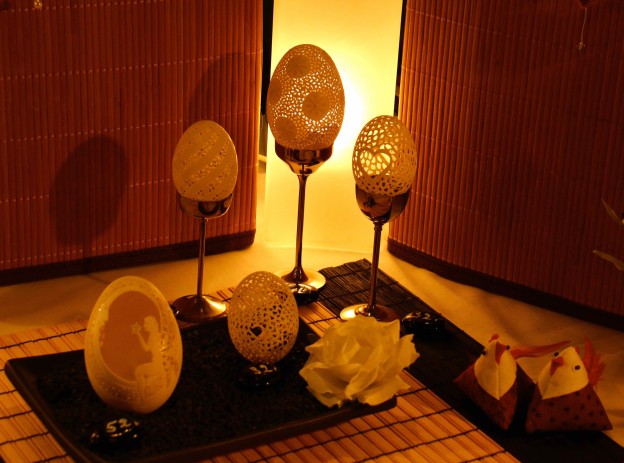We visited an Easter Egg market at nearby Maulbronn Monastery on a recent sunny Saturday.
This is what I was expecting:
Stands marketing delightful springtime decorations.
What I experienced, however, was a market set up inside one of the monastery buildings with table after table displaying intricately decorated eggs. And what a variety! This takes Easter egg decorating to a whole new level! There were a few eggs made of wood and porcelain but the vast majority were real eggs, of varying sizes, that had been hollowed out. Most of the eggs were hand-painted with spring themes such as flowers, butterflies, bunnies, etc., although one stand was devoted to eggs with animal motifs: sleeping cat, dog, horse, etc. These eggs could be mistaken for stones, perhaps due to the dark earthy colors of paint that completely covered the egg.
One artist created her designs by using colored wax and a tiny triangular-shaped feather as a paintbrush. She would work on one area of the egg, dipping the feather into the hot wax and then touching the feather to the egg. Once she finished creating a design in that area of the egg, she would set it aside allowing the wax to dry. This was a technique she was formally taught; in fact she had a photograph from 1955 of her in a classroom learning this technique. Another technique was to begin with the entire egg painted and then use a knife (like an Exacto knife) to scrape off the paint thereby creating a design. I observed two artisans utilizing this technique. (I asked each artisan before taking pictures and there were a number that would not allow it. Therefore, I have a few examples of what I saw but it doesn’t begin to cover every style.) Other artisans had covered eggs in small seed beads while one woman was making lace (using only her fingers and two spools/bobbins) that she would then wrap around the egg.
There was a table with Romanian-style decorated eggs; they reminded me of quilt patterns. The woman at that table had magnifiers attached to her glasses allowing her to paint the enormously intricate designs. Many of the other artisans had standing magnifying glasses.
There were a couple of different vendors displaying eggs with a ribbon trailing out of the egg; there was a message written on each ribbon. The egg had a dowel through the center and the ribbon was attached to the portion of the dowel residing inside the egg. The ribbon could be wound around the dowel and stored inside the egg. How was the ribbon attached to the dowel initially? Crazy!
There were a few different stands where the interior of the egg was displayed. There would be a 3 dimensional scene on the inside giving the appearance of looking through a window. One held a dancing ballerina, another held a Christmas tree, and a third had a small chess table set up, complete with wine glasses and a lamp! This one also had ‘doors’ on hinges so that the egg could be closed and simply look like an egg…except for the hinges!
I found the most stunning eggs to be ones that were hollow and had patterns cut out of the shell making it look like lace. In some cases, they were displayed with a light shining behind the egg to showcase the intricate artwork. These were the most expensive eggs priced up to 200 Euro each.
I left marveling over the intricate artwork. Upon further reflection, I have so many questions. Do the artisans cover the eggs with any type of material to make them a bit stronger? They certainly seemed extremely delicate and fragile. Do the artisans purchase eggs that have already been hollowed out or do they hollow the eggs out themselves? How many eggs break in transport? For that matter, how many eggs break while being decorated? I was so overwhelmed by the delicate beauty on display that I didn’t think to ask these questions of the artisans.
While looking up the specific information for the Maulbronn Easter Egg market, I learned that these markets sprout up in villages throughout Germany in the 40 days leading up to Easter – basically the season of Lent, between Ash Wednesday and Easter. Some markets have baby chicks and other exhibits that would appeal to children. Certainly one would want to find a safe area where children could spend their time since the egg displays are so fragile. While the Easter Egg markets don’t appear to be as large or as well-known as the Christmas markets, they are certainly worth a visit!














These are absolutely gorgeous! Do they also use emu and ostrich eggs? Thanks for sharing.
They really were beautiful. I know they claimed to use ostrich eggs, not sure about emu.
Reblogged this on Totally Inspired Mind….
Thank you!
So happy that I discovered your wonderful blog this morning, Terri! Although I live in the Midwest, Germany holds a very special place in my heart! I have visited my dear friends in Karlsruhe many, many times over the years. Maulbronn is such a lovely, peaceful place. I have visited the monastery three times. It would be so fascinating to visit during the Easter Egg Market one day! One of my dreams is to visit Germany in the Springtime. I have been fortunate to visit many times in the summer, once in Autumn, and once at Christmastime. I look forward to following your blog, Terri! Frohe Ostern! ♡
Danke! Ebenfalls! 😉
Wonderful market! I would enjoy this one more than a Christmas market, and I am afraid I would be buying some eggs…Thanks for taking us on this trip with you!
Full disclosure, Pat: I did buy one…for a gift. Then I was so worried about getting it to the recipient in one piece! 😮 It was a relief to hand it off! 😉
BRILLIANT CREATIVE ART WORK